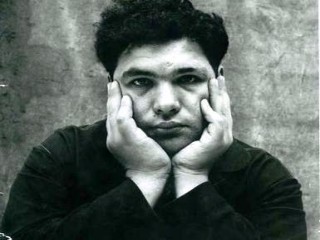
Eduardo Paolozzi biography
Date of birth : 1924-03-07
Date of death : 2005-04-22
Birthplace : Edinburgh, Scotland
Nationality : Scottish
Category : Arhitecture and Engineering
Last modified : 2011-08-24
Credited as : Artist sculptor, ,
0 votes so far
Paolozzi was the son of Italian parents, but was born and raised in Scotland. The family owned an ice cream and confection production and retail business. The young Paolozzi was supposed to join the business an adult. While he was employed in the business during his formative years, he was attracted to the aesthetics of the packaging and labels as well as the look of the advertisements. From a young age, Paolozzi thought like an artist, creating scrapbooks full of images culled from comic books and magazines.
The politics of his parents' mother country soon affected his life. Because of his father's support of Benito Mussolini and the Italian dictator's fascist politics, Paolozzi was sent to a youth camp for young fascists in Italy for a few summers in the 1930s. In 1940, after Italy became a part of World War II, Paolozzi and his father were labeled enemy aliens under the Emergency Powers Act. They were forced into an internment camp for three months. Soon after, Paolozzi's father and grandfather lost their lives when a torpedo sank a transport ship, the Arandora Star, that was taking them to Canada.
After Paolozzi's stint in the camp ended, he began studying at the Edinburgh College of Art in 1943. He wanted to become a commercial artist. His studies only lasted a few months because he was drafted by the British Army's auxiliary unit, the Royal Pioneer Corps. Paolozzi served from 1943 to 1944. Upon his discharge, he resumed his studies, this time at St. Martin's School of Art in London and Slade School of Art.
When Paolozzi was 23 years old and living in London, he had his first solo exhibit. Featured at this exhibit were examples of his early work, which primarily focused on collages later recognized as some of the first examples of British Pop Art. These collages were droll and full of wit. They were created from images of popular, middle-class culture, like magazines, photos of celebrities, and pictures of mass-produced consumer products.
Before earning a degree, Paolozzi left school in 1947 and spent the next two years living in Paris, France. He spent sometime studying at the Ecole des Beux-Arts, but primarily worked on developing his art. Paolozzi came in contact with many artists who influenced his style, including several Surrealists and avant-garde artists. After his return to London in 1949, he became known for cast-bronze sculptures that were unique at the time in their unfettered interpretation of the human form. The pieces also had a crude, unfinished quality to them. As his art career was taking off, Paolozzi was married in 1951 to a textile designer named Freda Elliot. The couple had three daughters before divorcing.
In London, Paolozzi was among the organizers of the Independent Group in the early 1950s. This society of like-minded young artists worked against the prevailing Modernist aesthetic. When the group had its first public event at London's Institute of Contemporary Arts in 1952, Paolozzi showed slides of his collage work in a talk called "Bunk." Lawrence Alloway, an art critic, called their work "Pop Art," which flowered in Great Britain in the 1950s.
Paolozzi's sculptures continued to evolve through the late 1950s. His figures began having machine parts incorporated into the design, but remained distressed in appearance. By the early 1960s, his sculptures took on a new, more Pop/futuristic look as the figures became more machine- or robot-like, were made of other metals like aluminum, and often painted in striking colors.
As Paolozzi's career developed, he worked in other mediums, including mosaics, textile design, silk-screen printing, and experimental films, with significant pieces in the latter mediums produced in the late 1960s. He also continued to create collages. While a working artist, Paolozzi also began teaching in this time period. He taught at institutions including the Royal College of Art in London, England, Fachhochschule in Cologne, Germany, and the Kuenste in Munich, Germany. At these institutions, he was an instructor in textile design, sculpture, and ceramics. His teaching career was limited by his difficult personality, and ended in 1990.
While Paolozzi often showed his work in group and solo shows, including a major retrospective in 1971 at London's Tate Gallery, the 1970s and 1980s were also a time when he created many works for public places. Related to his Pop Art roots was a mosaic he created in the 1970s for a London subway station. In the 1980s, Paolozzi sculpted a head in cast iron for Euston Square in London and a self-portrait in bronze for another street. With these public works also came public acknowledgement of his importance. He was elected to the Royal Academy of Art in 1979, and knighted ten years later.
Though Paolozzi continued to produce new works, it was not until the mid- to late-1990s that he showed his work in private galleries again. One such exhibit, entitled "Spellbound: Art and Film," was held at the Hayward Gallery in 1996. It consisted of new sculpture works, primarily in plaster, that were created in response to films. Paolozzi also continued to create large pieces of public art. In 1997, he finished one of his best-known works, a bronze statue of Sir Isaac Newton based on an image inspired by William Blake. It was placed on an exterior area of the British Library.
After a near-fatal stroke in 2001, Paolozzi suffered brain damage and was wheel-chair bound. He lived for another four years before dying in his sleep at the age of 81 at a hospital in London on April 22, 2005. He is survived by his daughters Louise, Anna, and Emma.



















